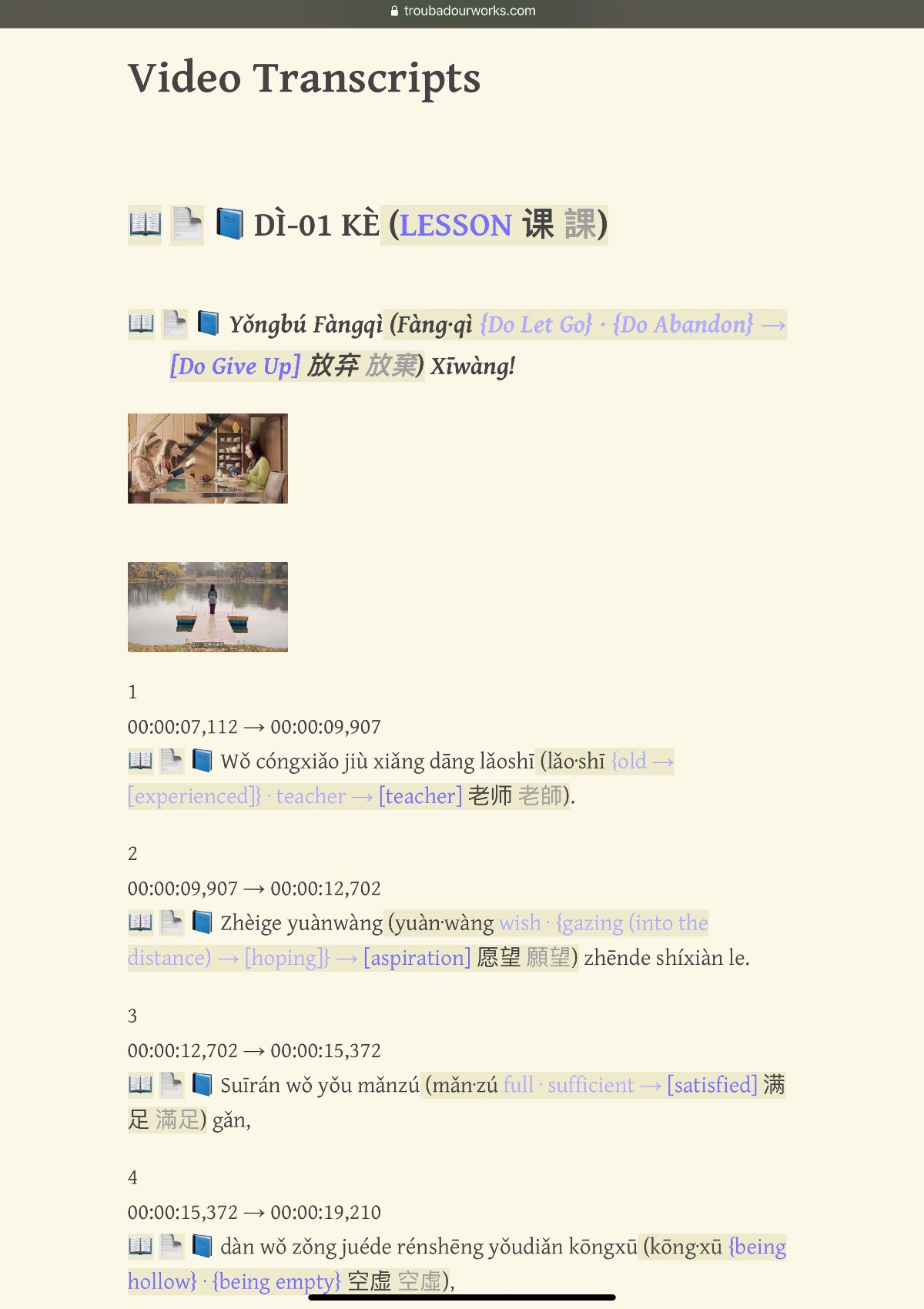MEotW: qìhòu biànhuà
The Mandarin Expression of the Week is:
What is the Ancient Chinese Force? Does it have a dark side?
Comments are enabled on this blog, so if you are so inclined, comment away!
A news feed for this blog is available here.
The Mandarin Expression of the Week is:
What is the Ancient Chinese Force? Does it have a dark side?
Comments are enabled on this blog, so if you are so inclined, comment away!
A news feed for this blog is available here.
The Mandarin Expression of the Week is:
What is transliteration? What is transcription? What is Pīnyīn?
Comments are enabled on this blog, so if you are so inclined, comment away!
A news feed for this blog is available here.
I am Chinese, but I boast in Jehovah, not in whatever knowledge I have of Chinese characters, those needlessly, self-indulgently complex products of human cultural tradition.
— tiandi, Links News (@TiandiLinksNews) November 15, 2022
Whenever _Pīnyīn_ helps me serve Jehovah more efficiently or effectively, I will not hesitate to use it. pic.twitter.com/q8KYO3j2me
“‘But let the one boasting boast about this:
— tiandi, Links News (@TiandiLinksNews) November 15, 2022
That he has insight and knowledge of me,
That I am Jehovah, the One showing loyal love, justice, and righteousness in the earth,
For in these things I take delight,’ declares Jehovah.”
—Jeremiah 9:24. https://t.co/fBxtq9TIRF
The Mandarin Expression of the Week is:
How does one Mandarin expression relate to mirrors, histories, and calendars, and to warp, weft, and scriptures?


Comments are enabled on this blog, so if you are so inclined, comment away!
A news feed for this blog is available here.
[NOTE: For spiritual food (which is for you yourself to learn spiritual things from, and which ideally should be in your own mother tongue), please go to jw.org.
The supplementary language-learning material mentioned in this post is for helping you to learn about how the Mandarin language is used in an official publication, so that you will be better able to help others in the Mandarin language field.]
Thankfully, an official Pīnyīn PDF file for the current songbook “Sing Out Joyfully” to Jehovah (sjj) is now available for download from jw.org. (The short link for the current songbook, tiandi.info/sjj, has the link and additional information.) Note, however, that the currently available official Pīnyīn PDF file (2020 Nián 3 Yuè Printing) only contains lyrics—it does not contain musical notation 🎼.
While we greatly appreciate the official Pīnyīn songbook PDF file that is available, the PDF format itself was conceived of in a world dominated by paper. Unfortunately, that means that PDF files are often not optimal for reading on the mobile devices that are now so prevalent among Mandarin field publishers.
Also, having to share limited display real estate with Chinese characters (and, in the past, musical notation 🎼) can in certain situations force the Pīnyīn text to be rendered in small type that can be difficult to read, especially for older people.
Another difficulty that is encountered, especially when one needs to quickly find the song that is about to be sung at a meeting, is that the official meeting schedules only list the numbers of the songs to be used, and the brothers announcing what song is about to be sung often only mention the song number, but in the current official Pīnyīn songbook PDF file, there is no listing of song links in song number order.
The official Pīnyīn “Sing Out Joyfully” to Jehovah (sjj) web material that is now available on jw.org and on the WOL addresses some of the above challenges, but it still does not put musical notation 🎼 together with Pīnyīn, and it still gives prime display real estate to Chinese characters, at the expense of the Pīnyīn.
Unofficial language-learning materials for all the songs for Mandarin 2022–2023 circuit assemblies, in the forms of proofread Pīnyīn web material (more correct than computer-generated Pīnyīn like that displayed by apps like Equipd, and more mobile-friendly than PDFs) or better, have been posted to this resource that seeks to help with the above-mentioned challenges:
Screenshots of the above web resource on iPhone and on iPad 📱. (It can also be used offline with apps like GoodReader, Documents, etc.) Tap/click on a screenshot to see it full-size.
Scheduling notes:
The Pīnyīn songbook material in the above unofficial resource has been designed to be mobile-first, so it works well on mobile devices of various shapes and sizes, including tablets and smartphones 📱 running iOS, iPadOS, Android, etc. Some of the ways in which it does so are:
The introduction for the above resource explains why it’s good to use Pīnyīn as a writing system on its own.
In the material with musical notation 🎼 in the above resource, expressions in the Pīnyīn lyrics do not trigger a Pīnyīn Plus “flashcard” to appear next to them as usual, because the lyrics need to stay aligned with the musical notation 🎼. As time allows, links will be added to Pīnyīn lyrics in the material with musical notation 🎼. Each of these links will cause a Pīnyīn Plus “flashcard” to appear near the top of the display.
Previously, musical notation 🎼 in the above resource was taken from screenshots of an official PDF file. Note (and make it a musical note ♪, at that 😄), though, that the musical notation 🎼 for song 77 marked the debut in the above resource of musical notation 🎼 produced “from scratch” to be mobile-first in design. This should provide for better and more consistent user experiences going forward, especially on smaller mobile devices like smartphones 📱.
[NOTE: While the organization expresses valid general concerns here about posting copies of official publications to the Internet, there are good legal and spiritual reasons for concluding that those concerns do not apply to this particular material, since such material should NOT be considered to be infringing on copyright, and since such material is specifically designed to be, NOT SPIRITUAL FOOD, but rather, material FOR LANGUAGE LEARNING. See this disclaimer for more information.]
The purpose of 3-line, _Pīnyīn_ Plus, etc. material was never to “go beyond the things that are written”. Rather, it has always been to help Chinese field language learners use “the things that are written” in Chinese characters, those overly complex products of human tradition.
— tiandi, Links News (@TiandiLinksNews) November 10, 2022
Of course, the organization should produce material in Chinese characters, for those who grew up learning and using them.
— tiandi, Links News (@TiandiLinksNews) November 10, 2022
For Chinese field language learners though, the extraordinarily complex characters are a burden and a distraction—they need to focus first on SPEECH.
Of course, it’s good to eventually learn as many Chinese characters as reasonably possible.
— tiandi, Links News (@TiandiLinksNews) November 10, 2022
However, SPEECH is the primary aspect of language. A good foundational understanding of Mandarin, etc. SPEECH will enable one to go on to better learn Chinese characters as time allows.
E.g., in Mandarin-English 3-line, _Pīnyīn_ Plus, etc. material, the _Pīnyīn_ simply represents the Mandarin speech itself, and the English helps language learners to build understanding of the Mandarin speech, which makes them useful & better equipped to later learn characters.
— tiandi, Links News (@TiandiLinksNews) November 10, 2022
The Mandarin Expression of the Week is:
When it comes to the Chinese languages, are Chinese characters and their visual designs more important than speech and its sounds?
Comments are enabled on this blog, so if you are so inclined, comment away!
A news feed for this blog is available here.
[NOTE: For spiritual food (which is for you yourself to learn spiritual things from, and which ideally should be in your own mother tongue), please go to jw.org.
The supplementary language-learning material mentioned in this post is for helping you to learn about how the Mandarin language is used in an official publication, so that you will be better able to help others in the Mandarin language field.]
Partially proofread Pīnyīn web material (more correct than computer-generated Pīnyīn like that displayed by apps like Equipd, and more mobile-friendly than PDFs) or better for Lesson 58 of the Learn From the Bible book has been added to the following resource:
In the above resource, the following web material is now available for the Mandarin Learn From the Bible book:
Note that like most of the other Pīnyīn Plus web material resources, the above resource can be used offline in supporting browsers. Also, an icon can be added to the home screen with supporting browsers.
[NOTE: While the organization expresses valid general concerns here about posting copies of official publications to the Internet, there are good legal and spiritual reasons for concluding that those concerns do not apply to this particular material, since such material should NOT be considered to be infringing on copyright, and since such material is specifically designed to be, NOT SPIRITUAL FOOD, but rather, material FOR LANGUAGE LEARNING. See this disclaimer for more information.]
The Mandarin Expression of the Week is:
Besides the fact that David was a king, what connection is there between the Mandarin words for “psalmist” and “hold political power”?
Comments are enabled on this blog, so if you are so inclined, comment away!
A news feed for this blog is available here.